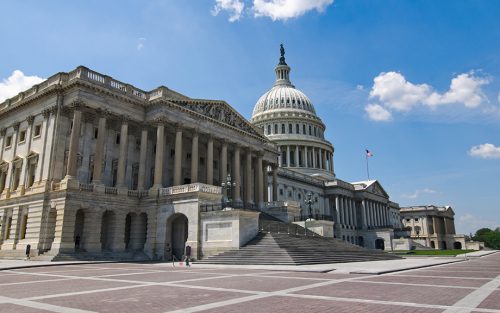This post presents an update of the economic forecasts generated by the Federal Reserve Bank of New York’s dynamic stochastic general equilibrium (DSGE) model. We describe very briefly our forecast and its change since October 2018. As usual, we wish to remind our readers that the DSGE model forecast is not an official New York Fed forecast, but only an input to the Research staff’s overall forecasting process. For more information about the model and variables discussed here, see our DSGE model Q & A.
Where Are Manufacturing Jobs Coming Back?

As we outlined in our previous post, the United States lost close to six million manufacturing jobs between 2000 and 2010 but since then has gained back almost one million. In this post, we take a closer look at the geographic dimension of this modest rebound in manufacturing jobs. While job losses during the 2000s were fairly widespread across the country, manufacturing employment gains since then have been concentrated in particular parts of the country. Indeed, these gains were especially large in “auto alley”—a narrow motor vehicle production corridor stretching from Michigan south to Alabama—while much of the Northeast continued to shed manufacturing jobs. Closer to home, many of the metropolitan areas in the New York-Northern New Jersey region have been left out of this rebound and are continuing to shed manufacturing jobs, though Albany has bucked this trend with one of the strongest performances in the country.
Monitoring Economic Conditions during a Government Shutdown

The recent partial shutdown of the federal government has disrupted publication schedules for many U.S. Census Bureau and Bureau of Economic Analysis (BEA) data releases. Most notably, the release of GDP for the fourth quarter of 2018—originally scheduled for January 30—has been postponed indefinitely.
The (Modest) Rebound in Manufacturing Jobs

The United States lost 5.7 million manufacturing jobs between 2000 and 2010, reducing the nation’s manufacturing employment base by nearly a third. These job losses and their causes have been well documented in the popular press and in academic circles. Less well recognized is the modest yet significant rebound in manufacturing jobs that has been underway for several years. Indeed, employment in the manufacturing industry began to stabilize in 2010, and the nation has added nearly 1 million jobs since then. Although modest in magnitude, this uptick in manufacturing jobs represents the longest sustained increase since the 1960s and bucks a decades-long trend of secular decline in employment in the goods producing sector of the economy. This is the first of two posts on the rebound in manufacturing jobs. In this post, we outline the manufacturing jobs recovery and assess which sectors within the manufacturing industry are driving this increase. The second post will focus on the geography of the manufacturing employment rebound. It will examine where manufacturing jobs are growing and where they are continuing to decline, with a focus on how areas in the New York-Northern New Jersey region have fared.
At the New York Fed: Fourth Annual Conference on the Evolving Structure of the U.S. Treasury Market
The New York Fed recently hosted the fourth annual Conference on the Evolving Structure of the U.S. Treasury Market. The one-day event was co-sponsored with the U.S. Department of the Treasury, the Federal Reserve Board, the U.S. Securities and Exchange Commission (SEC), and the U.S. Commodity Futures Trading Commission (CFTC). This year’s agenda, which included a series of keynote addresses and expert panels, focused on four key topics: 1) analytical approaches to debt issuance, 2) clearing and settlement, 3) developments in cash and repo markets, and 4) analysis of transactions data. Previous conferences were held in November 2017, October 2016, and October 2015.
Post‑Crisis Financial Regulation: Experiences from Both Sides of the Atlantic

To celebrate the 100-year anniversary of the Banca d’Italia’s New York office, the Federal Reserve Bank of New York and the Banca d’Italia hosted a workshop on post-crisis financial regulation in November 2018. The goal of the workshop was to discuss differences in regulation between the United States and Europe (and around the globe more broadly), examine gaps in current regulations, identify challenges to be addressed, and raise awareness about the unintended consequences of regulation. The workshop included presentations on such topics as market liquidity, funding, and capital requirements. In this post, we present some of the findings and discussions from the workshop.
The Indirect Costs of Lehman’s Bankruptcy

In our previous post, we assessed losses to customers and clients from foregone opportunities after Lehman Brothers filed for bankruptcy in September 2008. In this post, we examine losses to Lehman and its investors in anticipation of bankruptcy. For example, if bankruptcy is expected, Lehman’s earnings may decline as customers close their accounts or certain securities (such as derivatives) to which Lehman is a counterparty may lose value. We estimate these losses by analyzing Lehman’s earnings and stock, bond, and credit default swap (CDS) prices.
Customer and Employee Losses in Lehman’s Bankruptcy

In our second post on the Lehman bankruptcy [link to recovery blog], we discussed the cost to Lehman’s creditors from having their funds tied up in bankruptcy proceedings. In this post, we focus on losses to Lehman’s customers and employees from the destruction of firm-specific assets that could not be deployed as productively with another firm. Our conclusions are based in part on what happened after bankruptcy—whether, for example, customer accounts moved to other firms or employees found jobs elsewhere. While these indirect costs are difficult to pin down, the analysis suggests that the most notable losses were borne by mutual funds that relied on Lehman’s specialized brokerage advice and firms that used Lehman for its equity underwriting services.
Lehman’s Bankruptcy Expenses

In bankruptcy, firms incur expenses for services provided by lawyers, accountants, and other professionals. Such expenses can be quite high, especially for complex resolutions. The direct costs of bankruptcy proceedings reduce a firm’s value below its fundamental level, thus constituting a “deadweight loss.” Bankruptcy also carries indirect costs, such as the loss in value of assets trapped in bankruptcy—a subject discussed in our previous post (link). In this post, we provide the first comprehensive estimates of the direct costs of resolving Lehman Brothers’ holding company (LBHI) and its affiliates under Chapter 11 bankruptcy, and of Lehman’s broker-dealer (LBI) under the Securities Investor Protection Act (SIPA).
Creditor Recovery in Lehman’s Bankruptcy

Expectations of creditor recovery were low when the Lehman Brothers bankruptcy process started. On the day the firm filed for bankruptcy in September 2008, the average price of Lehman’s senior bonds implied a recovery rate of about 30 percent for senior creditors. A month later the bond price was implying a recovery rate of 9 percent, consistent with results from Lehman’s CDS auction. Two and a half years later, Lehman’s estate estimated that the recovery rate for holding company creditors would be just 16 percent. So, ten years after the filing, how much did creditors actually recover?










 RSS Feed
RSS Feed Follow Liberty Street Economics
Follow Liberty Street Economics